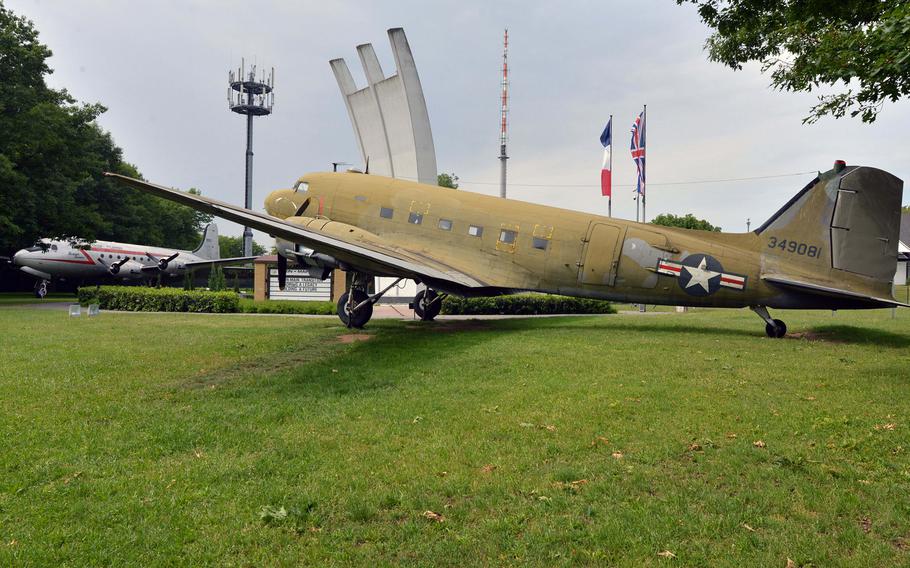
A Douglas C-47 ''Goonie Bird'' stands in the foreground at the Berlin Airlift Memorial on the edge of Frankfurt, Germany's international airport. The three fingers of the monument represent the three air corridors from West Germany to West Berlin. In the background is a Douglas C-54 Skymaster. (Michael Abrams/Stars and Stripes)
On June 24, 1948, the Soviets, in one of the opening moves of the Cold War, blockaded all rail, road and water access to West Berlin. Two days later, what is sometimes called the greatest peacetime aerial supply operation in history began — the Berlin Airlift.
American and British transport aircraft flew nearly around the clock to keep the city in the middle of the Soviet sector supplied, with among other things, food and coal.
Flying from a number of airports in West Germany and landing at West Berlin’s Tempelhof, Tegel and Gatow airports, the airlift kept the city and its people alive. At the height of the operation, a plane was landing at Tempelhof every 45 seconds.
By the spring of ’49, the Soviets realized the blockade had failed and ended it on May 12. To be sure the city was well supplied, the Allies continued the airlift until the end of September.
By then, their 227,264 flights had delivered 2.3 million tons of supplies to West Berlin.
One of the places Americans flew out of was Rhein-Main Air Base, near Frankfurt. It closed in 2005 to make room for an extension of the international airport, but on what was once its grounds stands a memorial to the airmen, civilians and aircraft that participated and perished in the airlift.
The centerpiece of the Berlin Airlift Memorial is the monument, a soaring concrete sculpture that ends in three prongs, representing the three air corridors the Allies could use to reach Berlin.
Its base is adorned with the names of the Americans who were killed in the airlift, mostly in plane crashes.
The monument, which was erected in 1985 and is a replica of one that stands at Tempelhof, is flanked by two U.S. Air Force airplanes. On the left, a Douglas C-54 Skymaster and to the right, a Douglas C-47 Skytrain, or as it was fondly called, a Goonie Bird. These were the main aircraft used in the operation, along with British Yorks and Dakotas.
The C-47 is named the “Berlin Train,” and its nose art features a bear, the symbol of Berlin, happily awaiting the arrival of an airplane from West Germany.
You can’t go inside the planes, unfortunately, but visitors are still fascinated by the old workhorses.
The memorial, which now stands on the grounds of Frankfurt Airport, also features a section of the Berlin Wall. Although it wasn’t built until 12 years after the Berlin Airlift ended, it was another example of Soviet strong-arm tactics over Berlin.
Also on display is a U.S. Air Force Rhein-Main Air Base sign and a panel that tells the airlift history.
The latest thing added to the site is a marker engraved with a bear and 550 km that marks the distance from there to Berlin (about 342 miles) by car. The planes supplying West Berlin during the airlift had to fly “only’’ about 270 miles to the city. The marker once stood nearby between the lanes of the autobahn.
If you’re interested in history or aviation, or you have time to kill while waiting to pick up someone from the airport, make a trip to the memorial and honor the deeds of the flyers seven decades ago.
abrams.mike@stripes.com
DIRECTIONS: The Berlin Airlift Memorial is on Frankfurt Airport grounds along Autobahn A5. Exit A5 at Zeppelinheim. Head toward Zeppelinheim, then take the first left into the woods. Follow the road to the parking places. From there, it is about a 700-yard walk to an airport viewing platform and a little farther to the memorial.TIMES: The memorial is open daily from 8 a.m. to 8 p.m. from May 1 to Sept. 30 and 8 a.m. to 5 p.m. from Oct. 1 to April 30.COSTS: FreeFOOD: There is no place to eat here. At the far end of the parking area, after going under the railroad tracks, there is a cafe. Other alternatives are at the Intercity Hotel nearby or at the airport.